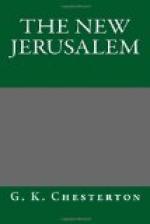CHAPTER XI
THE MEANING OF THE CRUSADE
There are three examples of Western work on the great eastern slope of the Mount of Olives; and they form a sort of triangle illustrating the truth about the different influences of the West on the East. At the foot of the hill is the garden kept by the Franciscans on the alleged site of Gethsemane, and containing the hoary olive that is supposed to be the terrible tree of the agony of Christ. Given the great age and slow growth of the olives, the tradition is not so unreasonable as some may suppose. But whether or not it is historically right, it is not artistically wrong. The instinct, if it was only an instinct, that made men fix upon this strange growth of grey and twisted wood, was a true imaginative instinct. One of the strange qualities of this strange Southern tree is its almost startling hardness; accidentally to strike the branch of an olive is like striking rock. With its stony surface, stunted stature, and strange holes and hollows, it is often more like a grotto than a tree. Hence it does not seem so unnatural that it should be treated as a holy grotto; or that this strange vegetation should claim to stand for ever like a sculptured monument. Even the shimmering or shivering silver foliage of the living olive might well have a legend like that of the aspen; as if it had grown grey with fear from the apocalyptic paradox of a divine vision of death. A child from one of the villages said to me, in broken English, that it was the place where God said his prayers. I for one could not ask for a finer or more defiant statement of all that separates the Christian from the Moslem or the Jew; credo quia impossibile.
Around this terrible spot the Franciscans have done something which will strike many good and thoughtful people as quite fantastically inadequate; and which strikes me as fantastically but precisely right. They have laid out the garden simply as a garden, in a way that is completely natural because it is completely artificial. They have made flower-beds in the shape of stars and moons, and coloured them with flowers like those in the backyard of a cottage. The combination of these bright patterns in the sunshine with the awful shadow in the centre is certainly an incongruity in the sense of a contrast. But it is a poetical contrast, like that of birds building in a temple or flowers growing on a tomb. The best way of suggesting what I for one feel about it would be something like this; suppose we imagine a company of children, such as those whom Christ blessed in Jerusalem, afterwards put permanently in charge of a field full of his sorrow; it is probable that, if they could do anything with it, they would do something like this. They might cut it up into quaint shapes and dot it with red daisies or yellow marigolds. I really do not know that there is anything better that grown up people could do, since anything that




